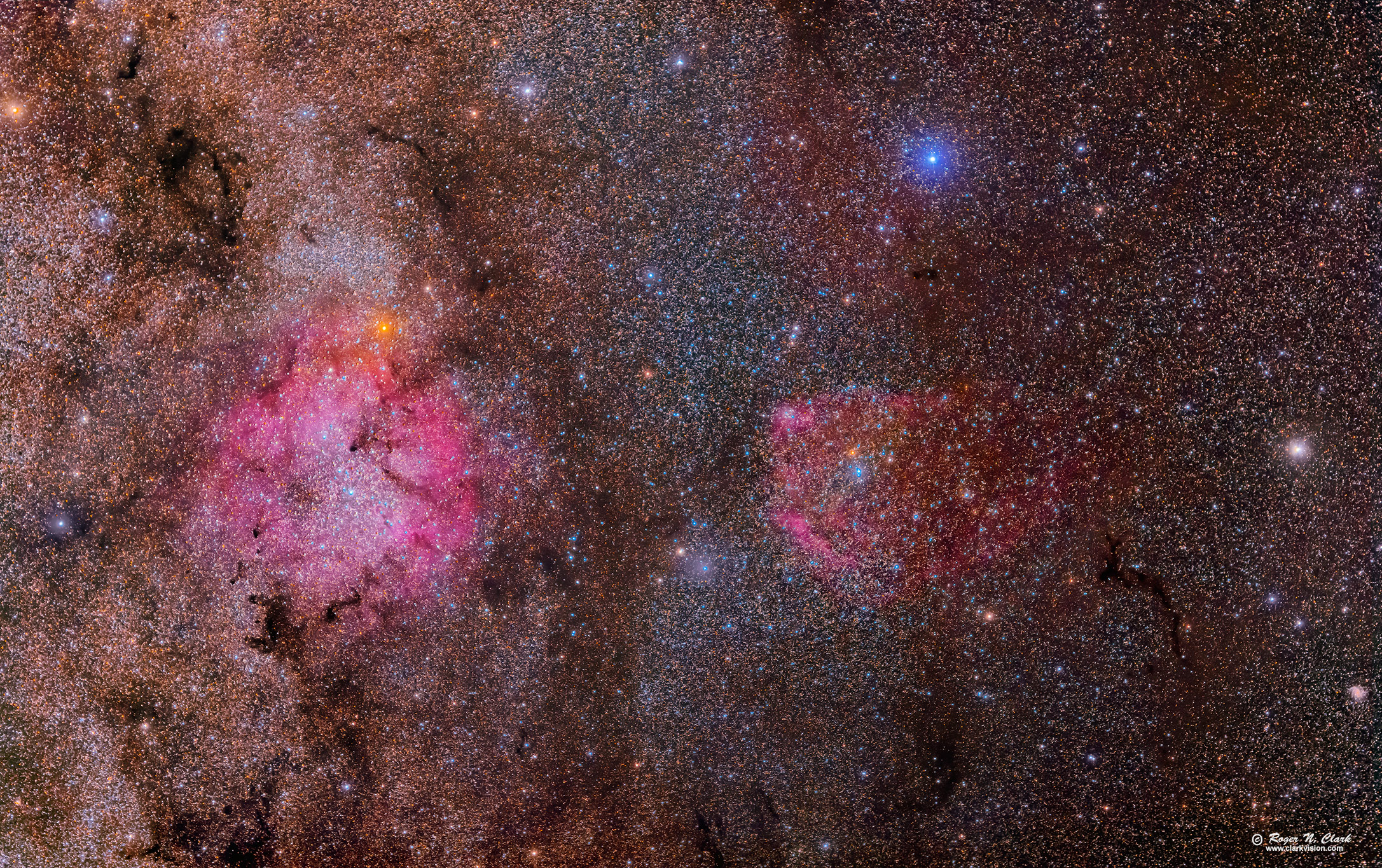| Home | Galleries | Articles | Reviews | Best Gear | New | About | Contact | Gallery Index | Previous |
Next |

| Home | Galleries | Articles | Reviews | Best Gear | New | About | Contact | Gallery Index | Previous |
Next |

The region of Cepheus, near the border with the Constellation Cygnus is very complex. The plane of the Milky Way galaxy is off the left edge of the image. Reddish-brown interstellar dust is seen throughout the image. The large pink nebula in the left half of the image is the Elephant Trunk Nebula (IC 1396). The pink color is emission from Hydrogen (H-alpha in the red, and H-beta plus H-gamma in the blue). In the right half of the image is SH2-129, a faint hydrogen emission nebula. In the center of SH2-129 is a bright blue star, and extending in the 2 to 8 o'clock direction is a lighter zone which is Oxygen Emission from the faint Ou4 nebula. Going through the middle of the image, top to bottom is a zone of blue stars, hot, relatively young stars. At the left edge, below center is the spiral galaxy, NGC 6946.
The OU4 nebula is difficult to discern because the natural color image recorded too many stars. I did an aggressive star reduction procedure, but the star density is still overwhelming to see faint nebulae. Along the strands of OU4 are many stars, which are not apparent in many online images made of the area with narrow band filters. The lesson here is the nebulae needs to be imaged with longer focal lengths, like 300 mm when imaging in RGB color to provide better separation of the nebulae and the many stars.
The image is a good illustration of the mix of colors of stars in our galaxy: a few blue stars more white stars and most stars are yellow, orange and red.
Technical. This image was obtained with a stock Canon EOS 90D DSLR Camera and a Sigma 105mm f/1.4 DG HSM Art Lens at f/1.4. Total exposure time was 95 minutes (190 thirty-second exposures) at ISO 1600. This is a natural color image. Post processing: raw conversion with Photoshop ACR and stacking with deep sky stacker. Stretched with rnc-color-stretch, and final adjustments in photoshop. No darks, no flats, no bias frames (flat field is in the ACR lens profile and corrected during raw conversion, bias is in the EXIF data). The exposures were tracked on a Fornax Lightrack II with no guiding. This is the full frame image after cropping edges from stacking and shown at 1/3 resolution (18.9 arc-seconds / pixel).
This is a natural color image.
The Exposure Factors, CEF, CEFA are measures of the relative amounts of light received from a subject. It can be used to fairly compare wildly different lens/telescope apertures and exposure times. For this image on the sky:
Modern digital cameras like the Canon 90D include on sensor dark current suppression technology and low fixed pattern noise at ISOs around 800 and higher, making no need for dark frame subtraction. Modern raw converters correct for light fall-off and also correct for hot/dead/stuck pixels. Bias is a single value found in the EXIF data. This makes processing low light images easy: simply align and average.
Also see Astrophotography Image Processing Basic Work Flow.
To learn how to obtain stunning images like this, please visit my Extensive Articles on Photography .
Keywords to this image = astrophoto-1 nebula galaxy low-light digital_astro canon_90d rnc-color-stretch NEW
Image ID: squid+elephant-trunk-rnclark-105mm-2022-av190-IMG_3521-641-i2-2173sw.jpg
| Home | Galleries | Articles | Reviews | Best Gear | Science | New | About | Contact |
Last updated May 11, 2024